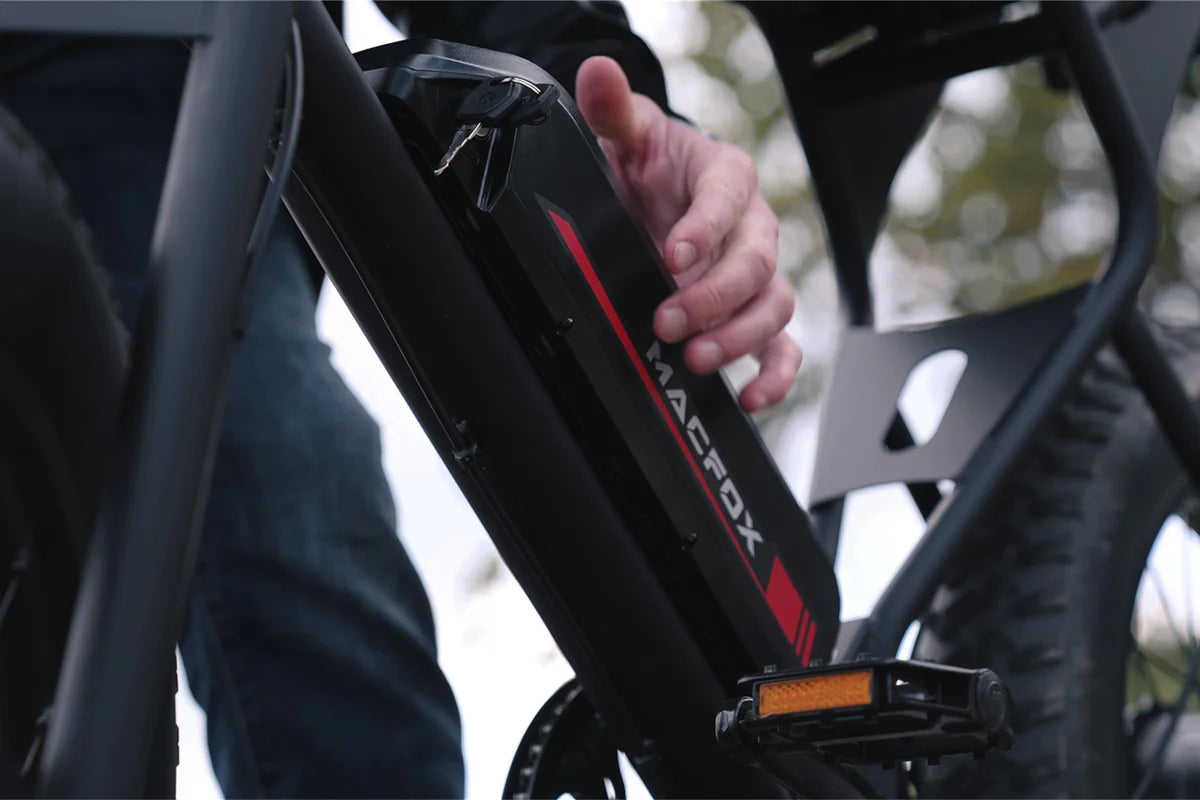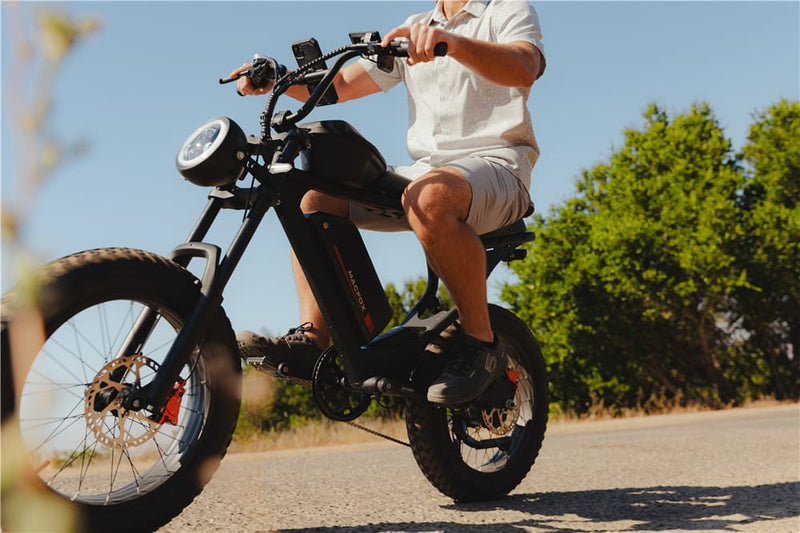Picture this: you're cruising on a scenic circuit, the wind carefully caressing your hair, and the sun casting a warm glow on your surroundings. You're not just riding any kind of bike; you're riding an electric bike, a marvel of contemporary design that makes climbing hills as easy as slicing a nice slab of butter. But what drives this amazing trip? Not something magical, but something equally fascinating - a simple battery.
Let's start an electrifying expedition into the globe of electrical bicycle batteries. From the rugged strength of Nickel-Metal Hydride to the innovative capacity of Solid-State batteries, we're diving deep right into the heart of what keeps your e-bike rolling. Whether you're a technology fanatic, an eco-warrior, or merely somebody that enjoys the adventure of the experience, recognizing these powerhouses will change the means you see your electric steed.
So, order your safety helmet and let's pedal via the ins and outs of Lithium-Ion, Lead-Acid, Lithium-Polymer, and past. It's not almost obtaining from A to B; it's about the journey, the advancement, and the fee that powers everything. Invite to the impressive globe of e-bike batteries!
Lithium-Ion Batteries (Li-ion)
The Heart of Modern Mobility
In the dynamic world of e-bikes, lithium-ion batteries stand out as the gold standard, powering most of today's e-bikes with unparalleled efficiency and effectiveness. These batteries literally revolutionize the way we think about and use electric trucks, offering the perfect combination of lightweight layout, high power capacity and long life. The Macfox X2 off road electric bike uses Samsung lithium batteries.
Why They Shine:
High Energy Thickness: The standout function of Li-ion batteries is their high power density. This suggests they can store extra energy in a smaller space, allowing e-bikes to take a trip longer ranges on a solitary cost without including unnecessary weight. Whether you're travelling to function or starting vacation experiences, Li-ion batteries make it possible to go further with much less.
Lightweight Advantage: Weight is an essential consider the efficiency of an e-bike. Li-ion batteries use a significant weight advantage over other types, boosting the bike's handling and making it simpler to carry or store when not in use. This lightweight nature does not jeopardize power; instead, it optimizes the e-bike's efficiency and cyclist's experience.
Reduced Self-Discharge Rate: Among the lesser-known yet extremely beneficial features of Li-ion batteries is their reduced self-discharge price. Compared to various other battery kinds, they retain their charge a lot longer when not being used. This characteristic is particularly helpful for e-bike individuals who might not use their bike daily, guaranteeing that the bike is ready to go when they are.
Long Life Expectancy: Longevity and long life are where Li-ion batteries absolutely succeed. They are developed to sustain hundreds to countless fee cycles before experiencing any kind of considerable loss in ability. This means an e-bike powered by a Li-ion battery can serve its rider for years, making it a smart investment for both informal motorcyclists and day-to-day travelers.
Ecological Influence: While no battery is completely free of environmental effect, Li-ion batteries are much more environmentally friendly than older kinds like Lead-Acid. They don't include heavy steels that can pose environmental hazards, and their longer life expectancy implies less batteries are needed over the life of an e-bike.
But, It's Not All Sunshine:
In spite of their many advantages, Li-ion batteries are not without their challenges. They are extra expensive than some options, mirroring their advanced technology and exceptional performance. In addition, they require mindful administration to preserve their durability, consisting of defense from extreme temperatures and appropriate billing practices. However, several modern e-bikes come outfitted with sophisticated battery management systems that assist minimize these issues, guarding the battery's health and optimizing its performance.

Nickel-Metal Hydride Batteries (NiMH)
The Durable Contender
Nickel-Metal Hydride batteries have carved out a particular niche in the e-bike world, providing a balance between efficiency, ecological influence, and cost. They represent a significant action up from the older Nickel-Cadmium (NiCd) batteries, generally because of their lack of harmful hefty steels and far better energy thickness.
Their Claim to Fame:
Eco-Friendly: NiMH batteries are much less harmful to the setting than their NiCd equivalents. They don't include cadmium, a toxic heavy metal, making them a more eco-conscious option for cyclists worried regarding their environmental impact.
Better Energy Thickness: Contrasted to NiCd batteries, NiMH provides a greater energy density, allowing for longer experiences on a solitary charge. This makes them a suitable choice for e-bike motorcyclists trying to find an equilibrium between performance and eco-friendliness.
Cold Weather Efficiency: NiMH batteries have a tendency to execute much better in cold weather than lithium-based batteries. This durability makes them a feasible option for cyclists in cooler environments who do not desire their e-bike's efficiency to experience when the temperature level drops.
Cost-Effectiveness: While they might not be as affordable as lead-acid batteries, NiMH batteries provide an excellent balance between price and efficiency. They are usually more economical than lithium-ion batteries, making them an enticing choice for budget-conscious riders.
Challenges to Consider:
In spite of their advantages, NiMH batteries do include some limitations. They have a greater self-discharge rate than Li-ion batteries, meaning they lose their charge quicker when not being used. Additionally, they are larger and bulkier than Li-ion batteries, which could influence the e-bike's weight circulation and total handling. They additionally do not have as long a life-span as Li-ion batteries, making them a less resilient long-lasting investment.
Related Reading: What Are The 3 Types of E-bikes?
Lead-Acid Batteries
The Old School Workhorse
Lead-Acid batteries have actually been around for a very long time and are the most traditional form of battery used in numerous applications, consisting of electric bicycles. They are understood for their dependability and reduced ahead of time price, making them an eye-catching option for entry-level e-bikes.
Key Features:
Cost-efficient: The most substantial benefit of lead-acid batteries is their price. They supply the lowest in advance expense among e-bike battery choices, making them available to a broader range of customers.
High Power Output: Lead-acid batteries can supply a robust power outcome, making them ideal for beginning electric motors and handling initial torque demands. This function makes sure that e-bikes can have a solid beginning and manage steep slopes.
Proven Reliability: With a lengthy history of usage in numerous automobile and industrial applications, lead-acid batteries have a tested record of dependability. They are well-understood, easy to manufacture, and commonly readily available.
Drawbacks:
Nevertheless, lead-acid batteries come with substantial disadvantages. They are much larger than NiMH and Li-ion batteries, which can affect the e-bike's performance and the biker's experience. Their power thickness is also lower, meaning they give much less range than other kinds of batteries of the exact same physical size. In addition, lead-acid batteries have a shorter lifespan and call for more upkeep, consisting of normal topping up of the electrolyte in some cases. Their ecological influence is additionally a problem, as they include lead and sulfuric acid, which can be harmful otherwise taken care of properly.
Lithium-Polymer Batteries (Li-Po)
The Flexible Powerhouse
Lithium-Polymer batteries represent a more current improvement in battery innovation, offering one-of-a-kind benefits over standard Lithium-Ion batteries. Their distinctive chemistry and building permit thinner, lighter, and a lot more adaptable battery designs, making them a favorite in high-performance e-bikes and portable electronic devices.
Advantages:
Versatility in Layout: Among the standout features of Li-Po batteries is their adaptability. Unlike the stiff framework of Li-ion batteries, Li-Po batteries can be shaped to fit into numerous areas within an e-bike's style, enabling more ingenious and aerodynamic shapes.
Lightweight: Li-Po batteries are extremely light, which decreases the total weight of the e-bike. This makes the bike much easier to take care of and can likewise boost its array, as less power is required to relocate a lighter things.
Safety and security and Stability: While all batteries bring some risk, Li-Po batteries are built with products that are much less susceptible to leaking and can use a higher level of security and security under normal usage problems. Their strong or gel-like electrolyte decreases the threat of leakage contrasted to the liquid electrolytes found in Li-ion batteries.
Considerations:
Nonetheless, Li-Po batteries are not without their obstacles. They commonly come with a higher cost because of their advanced modern technology and manufacturing processes. Furthermore, while they are generally thought about secure, they can still pose a fire risk if damaged or incorrectly charged. Their lifespan and total energy ability can likewise differ, usually depending on the top quality of the battery and its maintenance.

Solid-State Batteries
The Future Frontier
Solid-State batteries are at the forefront of battery modern technology advancement, guaranteeing to change not simply e-bikes however the whole range of electric vehicles and digital gadgets. These batteries change the fluid or gel electrolytes found in traditional batteries with a solid product, which can dramatically boost their performance and safety and security.
Promising Features:
Greater Energy Thickness: Solid-State batteries can store a lot more power than both Li-ion and Li-Po batteries, potentially providing much longer ranges for e-bikes on a solitary cost. This might dramatically decrease range stress and anxiety for cyclists and open brand-new opportunities for long-distance cycling experiences.
Increased Safety and security: The strong electrolyte made use of in these batteries is far much less most likely to leak or ignite, making Solid-State batteries a more secure alternative. This enhanced safety can result in even more compact and lightweight battery designs, as the need for protective housing is minimized.
Durability: Solid-State batteries are anticipated to have a longer lifespan, withstanding more charge cycles before their capacity starts to deteriorate. This long life can counter their greater initial cost with time, representing a sensible investment for major e-bike fanatics.
Current Limitations:
In spite of their potential, Solid-State batteries are still in the developing stage for e-bike applications. Obstacles consist of high manufacturing expenses, present constraints in automation capabilities, and the demand for additional research study to maximize their performance and longevity. However, as these technological hurdles are overcome, Solid-State batteries are poised to come to be a game-changer in the e-bike industry.
Comparison Table
| Battery Type | Energy Density | Weight | Lifespan | Cost | Pros | Cons |
|---|---|---|---|---|---|---|
| Li-ion | High | Light | Long (1000+ cycles) | High | Efficient, long-lasting, eco-friendly | Expensive, sensitive to temperature |
| NiMH | Moderate | Heavy | Moderate (500-700 cycles) | Moderate | Eco-friendly, cold weather performance | Higher self-discharge, shorter lifespan |
| Lead-Acid | Low | Very Heavy | Short (300-500 cycles) | Low | Cheap, reliable | Heavy, short range, environmental issues |
| Li-Po | High | Very Light | Moderate (500-700 cycles) | High | Flexible design, safe | Expensive, variable lifespan, fire risk |
| Solid-State | Very High | Light | Very Long (2000+ cycles) | Very High | Extremely safe, long-lasting, efficient | Expensive, not widely available |
Conclusion
Picking the appropriate battery for your electric bike involves thinking about elements such as weight, array, life expectancy, climate, and price. From the reliable Li-ion and NiMH to the emerging solid-state technology, each battery kind uses distinctive benefits and challenges. Whether you prioritize range, sturdiness, or are anticipating the future of e-bike technology, there's a battery type customized to your requirements, guaranteeing your trip is as reliable, safe, and enjoyable as possible.
FAQs
Which e-bike battery kind uses the lengthiest life-span?
Lithium-Ion batteries usually use the lengthiest life expectancy, with thousands of charge cycles before considerable capability reduction.
Can I utilize a Lithium-Polymer battery in cold weather?
Yes, yet their performance might reduce slightly in incredibly cold temperatures, similar to other battery types.
Are Solid-State batteries readily available for e-bikes now?
Currently, Solid-State batteries are still in growth and not commonly available for consumer e-bikes, yet they hold terrific promise for the future.

















